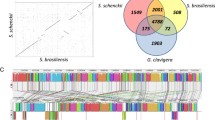Abstract
In order to understand the reproductive biology of pathogenic species in the Sporothrix schenckii complex, we characterized the partial mating type (MAT1-1) loci of Sporothrix schenckii, as well as the S. globosa MAT1-1-1 gene, which encoded 262 amino acid sequences. The data confirmed that the MAT1-1 locus of S. globosa was divergent from the MAT1-2 locus of the opposite mating type, suggesting that the fungus is heterothallic. To determine the mating type ratio of 20 isolates from Japanese patients, we analyzed the MAT loci by specific PCR amplification of MAT1-1-1 and MAT1-2-1 genes. The MAT1-1-1 was detected in 5 isolates but not in the other 15 isolates with the presence of MAT1-2-1. The MAT1-1:1-2 ratio of S. globosa isolates in Japan was estimated to be 1:3. Phylogenetic analysis indicated that the sequences of the MAT1-1-1 were identical among S. globosa isolates but different from S. schenckii and Ophiostoma montium.


Similar content being viewed by others
References
Berbee ML, Taylor JW. 18S Ribosomal RNA gene sequence characters place the human pathogen Sporothrix schenckii in the genus Ophiostoma. Exp Mycol. 1992;16:87–91.
Bubnick M, Smulian AG. The MAT1 locus of Histoplasma capsulatum is responsive in a mating type-specific manner. Eukaryot Cell. 2007;6:616–21.
Casselton LA. Fungal sex genes-searching for the ancestors. BioEssays. 2008;30:711–4.
de Beer ZW, Harrington TC, Vismer HF, Wingfield BD, Wingfield MJ. Phylogeny of the Ophiostoma stenoceras–Sporothrix schenckii complex. Mycologia. 2003;95:434–41.
de Meyer EM, de Beer ZW, Summerbell RC, Moharram AM, de Hoog GS, Vismer HF, Wingfield MJ. Taxonomy and phylogeny of new wood- and soil-inhabiting Sporothrix species in the Ophiostoma stenoceras–Sporothrix schenckii complex. Mycopatologia. 2008;100:647–61.
Hinrikson HP, Hurst SF, Lott TJ, Warnock DW, Morrison CJ. Assessment of ribosomal large-subunit D1–D2, internal transcribed spacer 1, and internal transcribed spacer 2 regions as target for molecular identification of medically important Aspergillus species. J Clin Microbiol. 2005;43:2092–103.
Kano R, Kawasaki M, Mochizuki T, Hiruma M, Hasegawa A. Mating genes of the Trichophyton mentagrophytes complex. Mycopathologia. 2012;173:103–12.
Kano R, Anzawa K, Mochizuki T, Nishimoto K, Hiruma M, Kamata H, Hasegawa A. Sporothrix schenckii (sensu strict S. globosa) mating type (MAT1-2) gene. J Dermatol. 2013;40:726–30.
Kwon-Chung KJ, Bennett JE. Distribution of α and a mating types of Cryptococcus neoformans among natural and clinical isolates. Am J Epidemiol. 1978;108:337–40.
Kwon-Chung KJ, Bartlett MS, Wheat LJ. Distribution of the two mating types among Histoplasma capsulatum isolates obtained from an urban histoplasmosis outbreak. Sabouraudia. 1984;22:155–7.
Kwon-Chung KJ, Bennett EJ. Dermatophytoses: medical mycology. Philadelphia: Lea & Febiger; 1992. pp. 707–729 and 816–826.
Marimon R, Cano J, Gené J, Sutton DA, Kawasaki M, Guarro J. Sporothrix brasiliensis, S. globosa, and S. mexicana, three new Sporothrix species of clinical interest. J Clin Microbiol. 2007;45:3198–206.
Marimon R, Gené J, Cano J, Guarro J. Sporothrix luriei: a rare fungus from clinical origin. Med Mycol. 2008;46:621–5.
Rodrigues AM, de Hoog S, de Camargo ZP. Emergence of pathogenicity in the Sporothrix schenckii complex. Med Mycol. 51: 405–412.
Rodrigues AM, de Hoog GS, Zhang Y, de Camargo ZP. Emerging sporotrichosis is driven by clonal and recombinant Sporothrix species. Emerg Microbes Infect. 2014;3:e32. doi:10.1038/emi.2014.33.
Romeo O, Scordino F, Criseo G. New insight into molecular phylogeny and epidemiology of Sporothrix schenckii species complex based on calmodulin-encoding gene analysis of Italian isolates. Mycopathologia. 2011;72:179–86.
Tamura K, Peterson D, Peterson N, Stecher G, Nei M, Kumar S. MEGA5: molecular evolutionary genetics analysis using maximum likelihood, evolutionary distance, and maximum parsimony methods. Mol Biol Evol. 2011;28:2731–9.
Thompson JD, Higgins DG, Gibson TJ. CLUSTAL W: improving the sensitivity of progressive multiple sequence alignment through sequence weighting, position-specific gap penalties and weight matrix choice. Nucleic Acids Res. 1994;22:4673–80.
Tsui CK, DiGuistini S, Wang Y, Feau N, Dhillon B, Bohlmann J, Hamelin RC. Unequal recombination and evolution of the mating-type (MAT) loci in the pathogenic fungus Grosmannia clavigera and relatives. G3: Genes| Genomes| Genetics. 2013;3:465–480.
Vásquez-del-Mercado E, Arenas R, Padilla-Desgarenes C. Sporotrichosis. Clin Dermatol. 2012;30:437–43.
Zhou X, Rodrigues AM, Feng P, de Hoog GS. Global ITS diversity in the Sporothrix schenckii complex. Fungal Divers. 2014;66:153–65.
Zipfel RD, de Beer ZW, Jacobs K, Wingfield BD, Wingfield MJ. Multigene phylogenies define Ceratocystiopsis and Grosmannia distinct from Ophiostoma. Stud Mycol. 2006;55:77–99.
Acknowledgments
This study was supported by grants from the Academic Frontier Project of the Ministry of Education, Culture, Sports, Science, and Technology (MEXT) and Nihon University Multidisciplinary Research Grant for (2013).
Author information
Authors and Affiliations
Corresponding author
Rights and permissions
About this article
Cite this article
Kano, R., Tsui, C.KM., Hamelin, R.C. et al. The MAT1-1:MAT1-2 Ratio of Sporothrix globosa Isolates in Japan. Mycopathologia 179, 81–86 (2015). https://doi.org/10.1007/s11046-014-9808-7
Received:
Accepted:
Published:
Issue Date:
DOI: https://doi.org/10.1007/s11046-014-9808-7




